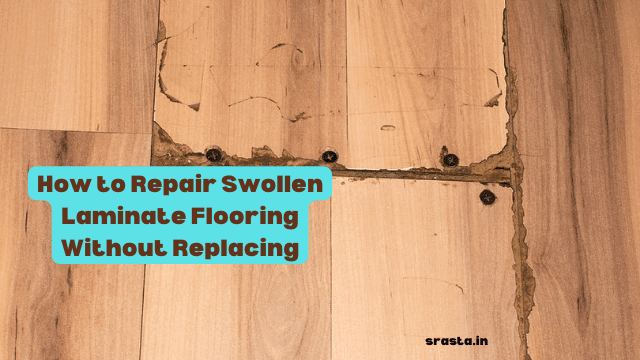Laminate flooring is a popular choice among homeowners because of its durability and affordability. However, like any other flooring material, it is susceptible to damage over time. One of the most common problems with laminate flooring is swelling. Swelling can be caused by a variety of factors, such as moisture, poor installation, or an inadequate subfloor. If left unaddressed, swollen laminate flooring can cause a range of problems, including buckling, warping, and even mold growth. Fortunately, repairing swollen laminate flooring is possible without having to replace the entire floor. In this article, we’ll discuss how to repair swollen laminate flooring without replacing it.
Understanding Swollen Laminate Flooring
Before we dive into how to repair swollen laminate flooring, it’s essential to understand what causes it. Swollen laminate flooring occurs when the planks absorb moisture and expand. This can happen due to a variety of reasons, such as a leak or a spill that isn’t cleaned up promptly. Poor installation, inadequate underlayment, and high humidity levels can also contribute to swelling. When laminate flooring swells, it can buckle, warp, or even lift from the subfloor. It’s crucial to address swelling as soon as possible to prevent further damage.
Materials Needed
Repairing swollen laminate flooring doesn’t require many materials, but you’ll need to gather a few things before you start. Here’s what you’ll need:
- Replacement planks or pieces of laminate flooring
- Saw
- Chisel
- Hammer
- Adhesive
- Cleaning solution
- Towel
- Heavy object
Steps to Repair Swollen Laminate Flooring
Now that you have your materials, let’s discuss how to repair swollen laminate flooring. Follow these steps carefully to ensure a successful repair.
Step 1: Identify the Swollen Planks
Before you can start repairing your swollen laminate flooring, you’ll need to identify which planks are affected. Look for planks that are higher than the surrounding planks or appear to be buckled or warped. Use a moisture meter to determine the extent of the swelling.
Step 2: Remove the Damaged Planks
Using a saw, carefully cut through the center of the swollen plank. Use a chisel and hammer to pry the plank up from the subfloor. Be sure to remove any adhesive or debris from the subfloor before proceeding.
Step 3: Prepare the Replacement Plank
Cut the replacement plank to size using a saw. Apply adhesive to the back of the replacement plank and carefully fit it into the empty space left by the removed plank. Use a heavy object to apply pressure to the replacement plank and allow the adhesive to dry completely.
Step 4: Clean the Floor
Clean the entire floor using a cleaning solution and a towel. Be sure to remove any debris, dust, or adhesive from the surface.
Tips to Prevent Swollen Laminate Flooring
Preventing swollen laminate flooring is always better than repairing it. Here are some tips to keep your laminate flooring in good condition:
- Clean up spills and leaks immediately.
- Use a humidifier or dehumidifier to maintain optimal humidity levels.
- Install a moisture barrier or underlayment.
- Avoid mopping your laminate flooring with excessive water.
- Ensure proper installation by a professional.
Conclusion
Swollen laminate flooring can be a frustrating problem, but it doesn’t have to mean replacing the entire floor. By following the steps outlined in this article, you can repair swollen laminate flooring quickly and easily. Remember to identify the affected planks, remove them carefully, prepare the replacement plank, and clean the floor thoroughly. With the right tools and techniques, you can fix your swollen laminate flooring and enjoy your beautiful, durable and affordable flooring for years to come. By taking steps to prevent swelling in the first place, you can ensure the longevity of your laminate flooring.
FAQs
- How do I know if my laminate flooring is swollen?
You can tell if your laminate flooring is swollen by looking for planks that appear higher than the surrounding planks or are buckled or warped. You can also use a moisture meter to determine the extent of the swelling.
- Can swollen laminate flooring be repaired?
Yes, swollen laminate flooring can be repaired by removing the damaged planks and replacing them with new ones. It’s essential to address swelling as soon as possible to prevent further damage.
- What causes laminate flooring to swell?
Laminate flooring can swell due to a variety of reasons, such as moisture, poor installation, or an inadequate subfloor. It’s important to identify the cause of the swelling to prevent it from happening in the future.
- How can I prevent my laminate flooring from swelling?
You can prevent your laminate flooring from swelling by cleaning up spills and leaks immediately, maintaining optimal humidity levels, installing a moisture barrier or underlayment, avoiding excessive water when mopping, and ensuring proper installation by a professional.
- Do I need to replace my entire laminate flooring if it’s swollen?
No, you don’t need to replace your entire laminate flooring if it’s swollen. You can repair the affected planks by removing them and replacing them with new ones. However, it’s important to address swelling as soon as possible to prevent further damage.


Recent Comments